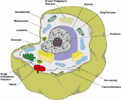 Teacher Guide to Plant and Animal Cells
Teacher Guide to Plant and Animal Cells
Excuse me, I beg your pardon. Are you a plant or animal? That might seem like a funny question for someone to ask of another. Why would someone be confused by a subject like that? Well, at the cellular level, we have a lot in common with plants. Except for the cellulose cell wall unique to plants, animals have several identical characteristics in the make up of their cells.
Of course there are important differences, but there are three things about both plant and animal cells that all plants and animals have in common.
Proper Nucleus
Both plant and animal cells are said to be eukaryotic. That simply means that both types of cells have a proper nucleus. This proper nucleus, common to both plant and animal cells, contains chromosomes. Chromosomes carry genes which are small parts of DNA. This is the genetic material that is passed on to family members from generation to generation. The next time you see a family resemblance between your family, you will know it is because of the chromosomes contained in a proper nucleus.
Cytoplasm
Within the Cytoplasm it is the proper nucleus that keeps the chromosomes separated from the cytoplasm. All plant and animal cells have cytoplasm which contain mitochondria. Mitochondria are very small, and resemble bacteria when viewed under an electron microscope. Mitochondria contain enzymes which is very important because it is these enzymes that draw energy from glucose. This is significant and necessary for the life of both the plant and the animal to survive. Mitochondria also contain small amounts of DNA which is known to control how they behave.
Cell Membrane
The third common thing between plant and animal cells is a cell membrane. Even thought the cell membrane that surrounds the cell is very thin, it is able to limit what can enter or leave the cell.
As we mentioned before there is one great different between plant and animal cells. Only animal cells have a cell wall. This cell wall is unique in that it is not alive. It is made of cellulose which allows the cell to build up great pressure inside the cell because of osmosis. This is the transfer of water.
Some things to pass through and not others. The semi-permeable cell membrane will allow water to enter or leave the cell through osmosis. Plant cells can absorb water through osmosis but will not break because of the cell wall. Animal cells do not have a cell wall. What this means to animals is that they must excrete any excess water that the cells cannot hold.
The next time you take a drink of water, think of the cells taking in water by osmosis and be thankful that you have kidneys to rid your body of excess water. Without them, and unless you are a plant, you don't have a cell wall to keep your cells from exploding from excess water. Ouch!
Related Teacher Resources That Are Worth A Look:
- Arbor Day Clip Art
- Cell-Biology.com
- CELLS alive!
- Cell Analogies Collage
- Cells For Kids
- Cell Structure and Function
- Community Cell
- It's Alive, Alive, Allllllllllliiiiiiivvvvveeee!
- It's Just a Phase They're Going Through!
- The Biology Project: Cell Biology
- The Incredible, Edible Cell!
- Virtual Cell